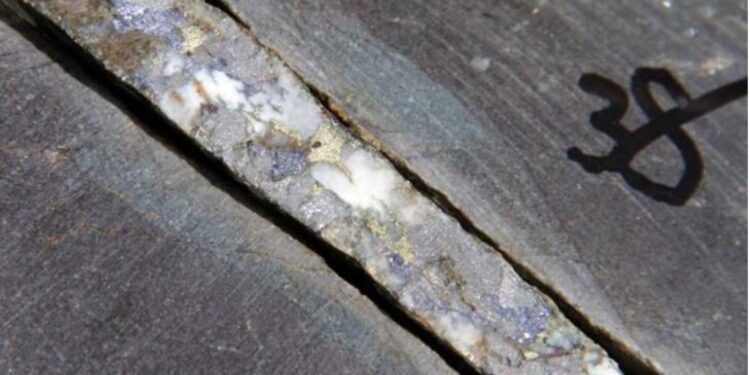Lode Resources Ltd (ASX: LDR) has added two new projects to its base metal portfolio though the granting of Exploration Licence No. 9319 by the Government of New South Wales.
Exploration Licence No. 9319 (Sandon), which encompasses an area 758 sq. km , is located 50km northwest of Armidale and increases the Exploration Licence area under control by LDR to 1,728 km2 , an increase of 78%.
Exploration Licence No. 9319 incorporates a number of metal occurrences (Cu, Pb, Zn, Ag & Sb) with the two most prominent being the Bundarra Copper and the Abington Base Metal Projects. Extensive historic surface work means minimal preliminary work needed for drill target definition. Typical of the New England Fold Belt these projects are highly prospective but very under explored with only several drill holes recorded in the entire 758 sq. km area.
Bundarra Copper Project
Copper was extracted from the Bundarra Mine during the 1890’s and early 1900’s. Although no production records are known to exist mine plans shows underground mine workings extend to a vertical depth of approximately 75m.
The Amoco Minerals Australia Company1,2,3,4 carried out extensive surface exploration over the Bundara Copper Project from 1976 to 1979, investigating the potential for volcanogenic massive copper-lead-zinc sulphide deposits (VMS).
Work carried out included geological mapping, soil sampling, various geophysical techniques including aero magnetics, ground magnetics, gravity PEM and self-potential.
A significant gravity anomaly located at the southern end and another weaker gravity anomaly located at the northern end of the survey area both coinciding with copper in soil anomalies.
Neither of these targets were drill tested. It’s worth pointing out that very strong soil anomalism surround the Bundarra copper mine is almost certainly contamination from copper beneficiation and smelting, so the high amplitude of this anomalism can be ignored.
Subsequent to the extensive surface work 3 holes were drilled in the vicinity of the Bundarra copper mine. Drill hole BDNSW-78-1 targeted what was considered to be the down dip extrapolation of the Bundarra mine copper mineralisation.
This single hole intersected mineralisation from 119.7m to 120.2m grading 2.13% Cu, 0.65% Zn & 7.3 g/t Ag however significant longitudinal areas remain untested.
The two subsequent holes were drilled 150m north and south of BDNSW-78-1 but failed to intersect significant mineralisation.
A preliminary review of the geological logs suggests that lithologies intersected in the southern hole may have been too high in the geological sequence and the northern hole too low.
Historically mined mineralisation at the Bundarra copper mine is believed to have developed syngenetically on the pyritic chert and metabasalt contact which its typical for VMS deposits.
Abington Base Metal Project
The Abington Project was historically described as a VMS Cyprus-type C mineralisation occurrence of gold and copper with minor lead and zinc stratigraphically hosted within Sandon Bed units. Similar VMS stratiform occurrences of Au and Cu are recorded further to the east along Abington Creek. However, the Abington prospect is likely to be an intrusive related base metal occurrence based on preliminary work done by Sovereign Gold Company.
Sovereign reported mineralised breccias containing lensoidal to massive sphalerite, chalcopyrite, pyrrhotite and pyrite in several NE-NNE fracture zones with alteration selvedge’s of chloritisation, sericitization, silicification, pyritization and kaolinisation.
Sovereign carried out a 1.5 x 2 km soil survey defining anomalous silver and significant base metal elements however preliminary drilling appears to have primarily targeted a barren ferruginous-silicious gossan unit and not the strongest soil anomalies.
Drill hole ZK001 intersected veining (mainly sheeted) scattered throughout the entire downhole length of 249.8m containing Ag, Pb, Cu and Zn and As mineralization. The highest concentration is in the first 100m – not economic but very significant.
This mineral assemblage is typical of polymetallic veins associated with fractionated granitic intrusives. Metamorphic products are non-foliated and are best interpreted as being the result of contact metamorphism caused by a nearby granitic intrusive.
A fracture system developed above a buried mineral generating pluton has the potential of being a large mineralised system. Regional magnetics show a likely intrusive complex, with Abington sitting above what appears to be a 1km wide intrusive stock/pluton.
A number similar magnetic anomaly exits over strike length of several kilometres and warrant preliminary surface exploration such as mapping and geochemical sampling.
For further information please visit: https://loderesources.com/












